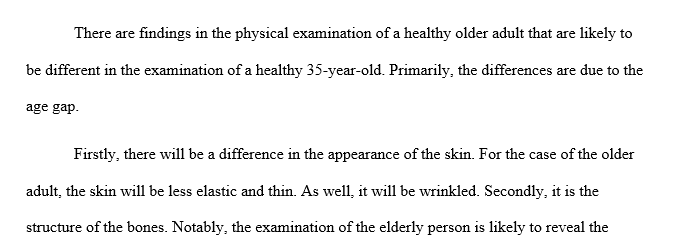Health Assessment
Discussion Question:
In general, what findings in the physical assessment of a healthy older adult do you expect to be different than that of a healthy 35-year-old?
Your initial posting should be at least 400 words in length and utilize at least one scholarly source other than the textbook.
Module Course Learning Objectives (CLO)
After completing this module, students will be able to:
- CLO 1: Demonstrate skill in systematic data collection methods: Interviewing, observation, physical examination, and mental health assessment (PLG 3; UMBO 3, 4, 5)
- CLO 2: Apply anatomical, physiological, psychosocial, nutritional, developmental norms and theories, cultural and environmental factors to interpret health assessment data (PLG 3, UMBO 3, 4, 5)
- CLO 3: Differentiate normal findings for the client’s age, developmental stage, and cultural background and those unusual or abnormal findings, which need further evaluation (PLG 3; UMBO 3, 4, 5)
- CLO 5: Communicate health assessments effectively in both oral and written form (PLG 3; UMBO 3, 4, 5)
Overview
Primary aging reflects changes in physiologic reserves over time that are independent of and not induced by any disease. These changes are especially apt to appear during periods of stress, such as exposure to fluctuating temperatures, dehydration, or even shock. Decreased cutaneous vasoconstriction and sweat production can impair responses to heat; declines in thirst may delay recovery from dehydration; and the physiologic drops in maximum cardiac output, left ventricular filling, and maximum heart rate seen with aging may impair the response to shock.
At the same time, the aging population displays marked heterogeneity. Investigators have identified vast differences in how people age and have distinguished “usual” aging, with its complex of diseases and impairments, from “optimal” aging. Optimal aging occurs in those people who escape debilitating disease entirely and maintain healthy lives late into their 80s and 90s. Studies of centenarians show that genes account for approximately 20% of the probability of living to 100, with healthy lifestyles accounting for approximately 20% to 30%.10,11 These findings provide compelling evidence for promoting optimal nutrition, strength training and exercise, and daily function for older adults to delay unnecessary depletion of physiologic reserves.
References
Binkley, L. (2017). Bates’ guide to physical examination and history-taking (12th ed.) Philadelphia, PA: Lippincott Williams & Wilkins. ISBN: 978-1469893419
Professional Standards
- AACN Baccalaureate Essential 3: Scholarship for Evidence-Based Practice
- AACN Baccalaureate Essential 6: Interprofessional Communication and Collaboration for Improving Patient Health Outcomes
- AACN Baccalaureate Essential 7: Clinical Prevention and Population Health
- IOM Core Competency 1: Patient-Centered Care
Read
- Bickley, L. (2017). Bates’ guide to physical examination and history-taking (12th ed.). Philadelphia, PA: Lippincott Williams & Wilkins. ISBN: 978-1469893419 . Read chapter 20.
543 Words
APA
